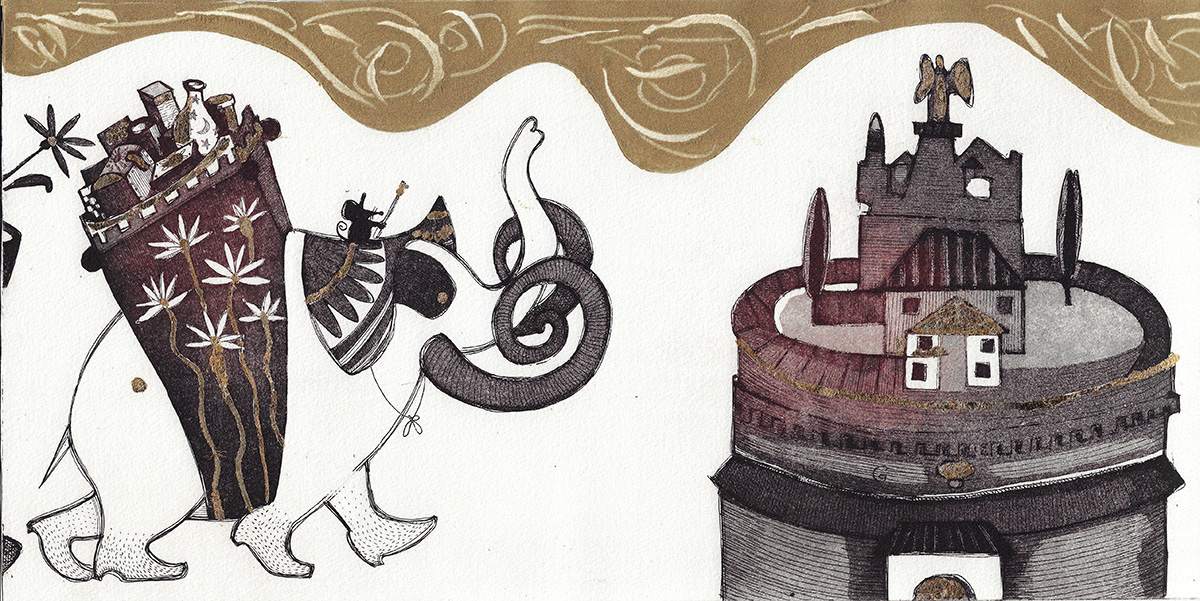Valeria Gasparrini
Artist, illustrator
About
Valeria Gasparrini ( Rome, 1964), was formed thanks to a rich contribution of artistic and literary experiences: classical studies, research in ceramics, painting, fresco, engraving, drawing from life; attended the three-year course of illustration at the IED, and was trained in the graphic engraved at the Stamperia del Tevere , in Rome. Today she works as an artist, as an advertising illustrator and freelance editorial, as a teacher of drawing, visual and illustration at Quasar Design University, the Academy of Fine Arts of L'Aquila ABAQ, the American University in Rome AUR. He draws live in theatrical performances, and realizes performances with stage machines of various nature that builds and animates on stage. As an artist he has participated in personal and collective exhibitions, and passionately dedicates himself to the creation of artist’s books, combining his remarkable illustrative nature with the infinite expressive possibilities of engraving techniques.
He has exhibited in Rome, Milan, Bologna, Faenza, Venice, Paris, Luxembourg, Rothemburg. Some of his works are part of permanent exhibitions, such as the ceramic work "Rain" at the International Museum of ceramics in Faenza, the artist book "How many irreplaceable lives", exhibited at the national library of Luxembourg, and its printed version exhibited at the Casa della Memoria in Rome.
They wrote about here
Daniele Scalise, Loris Schermi, Francesca Tuscano, Michèle Wallenborn, Devin Kovach, Sarah Linford, Gianluca Tedaldi. Valeria Bertesina. For interested people, I am writing to offer the highest recommendation for Valeria Gasparrini who has held two engraving workshops for the Rome Center of Architecture and Culture at Woodbury University which I direct. He guided the students' works, taking them from the initial drawings to the creation of the definitive prints and their possible display in an exhibition. I find her one of the most creatively contagious and inspiring people with whom I have had the opportunity to collaborate. Let me take the liberty of offering a few details regarding his remarkable abilities. To begin with, she is a very competent artist in her field. She is also generous in sharing her experience and does so with great enthusiasm. In the initial phase of the projects he offers numerous approaches, both experimental and conventional, with the aim of giving birth to works of art that can then be created on slabs. In the workshops we used zinc and copper plates, and the results were surprising. It featured field sketching exercises, complex mapping projects, and digital plate file translations. It has provided Woodbury with some of the most powerful and transformative learning experiences students have had in Rome; also in relation to what they do at home. Our students love her and she has been there for them every step of the way, teaching them techniques to achieve their creative goals. It is a magical moment when the students complete the drawings, prepare the plates, ink them working in their studio. And then they print them. This would not have been possible for us without Valeria's expertise. Thank you for the opportunity to offer a great recommendation for Valeria and I would be happy to discuss her merits further should you wish to contact me at my email: paulette.singey@gmail.c
Best regards Paulette Singley Woodbury University professor, Director of the Rome Center for Architecture and Culture
L’acquatinta

Aquatint technique allows to enrich the matrix of chiaroscuro tones. These halftones will not be due to hatching -as in etching- but to the use of this technique that allows to create homogeneous backgrounds. You sprinkle the sheet with resin powder (rosin), it heats up so that it adheres by fusion, you protect the areas that you do not want to corrode, and you put in acid. With this technique the acid acts only in the exposed spaces between the rosin grains, obtaining as a result a rough surface that will retain the ink; returning a pattern campitura in the printing phase. Depending on the time of bite the microscopic points will be more or less deep and marked, which allows you to make various shades of gray in the print. The aquatint can be made on the same matrix used for etching (enriching it), or on a different matrix but with the same measurements, so you can then superimpose and print them in succession in register. In this case the backgrounds given by the aquatint can have a different color from the marks of the etching.
The time of exposure to the acid of a plate prepared in aquatint varies from 20 seconds to about 5 minutes; however, it is good to do before the tests to verify the action of the acid. Nitric acid is more manageable and clean than copper sulfate, although the latter can still achieve excellent results. The acid will be used at a dilution that allows a gentle and little aggressive; too long exposure “burns” the slab, in the sense that the micro-incisions that make up the texture thickly dotted if left in acid for too long join together and lose the fine-grained effect that distinguishes the aquatint. Different grenade effects can be obtained with rosin powder more or less sieved – then more or less coarse.
The aquatint can also be obtained by spraying spray paint on the plate, putting in acid and then removing the paint. This mode also allows you to get some nuances.
